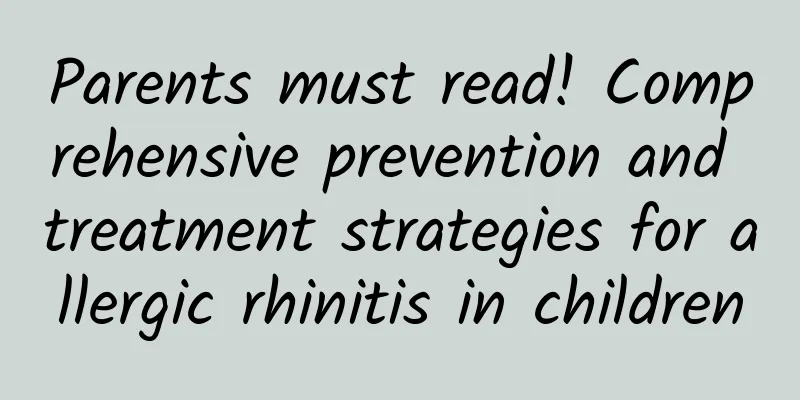Parents must read! Comprehensive prevention and treatment strategies for allergic rhinitis in children

|
Author: Zhao Jing, Chief Physician, Children's Hospital, Capital Institute of Pediatrics Reviewer: Gu Qinglong, Chief Physician, Children's Hospital Affiliated to Capital Institute of Pediatrics Allergic rhinitis is one of the common chronic diseases in children, which affects their daily life and learning efficiency. Faced with this challenge, parents are often confused and do not know how to help their children effectively control the disease. Therefore, it is particularly important to master scientific and effective treatment methods. 1. Four-in-one treatment principle 1. Identify allergens The first step in treating allergic rhinitis is to identify the allergens. There are many types of allergens, including pollen, dust mites, animal dander, mold, etc. Through professional allergen testing, such as skin prick tests or serum-specific IgE tests, children's allergens can be accurately identified, providing an important basis for subsequent treatment. 2. Avoid allergens Avoiding allergens is one of the key measures to treat allergic rhinitis. Parents should try to keep their children away from known allergens based on the test results. For example, children who are allergic to pollen should reduce their outdoor activities during the peak pollen season, or wear protective equipment such as masks and glasses; children who are allergic to dust mites should keep their home environment clean, change bedding regularly, and use a dust mite remover. In addition, nasal barrier agents, as a local protective measure, can also reduce the inhalation of allergens to a certain extent. 3. Medication Drug treatment is an important means to relieve the symptoms of allergic rhinitis. Commonly used drugs mainly include antihistamines, nasal hormones and leukotriene receptor modulators. Antihistamines, as the first-line medication, have the characteristics of small side effects and significant efficacy, and are especially suitable for patients with mild to moderate allergic rhinitis. For patients with more severe symptoms, nasal hormones can be used in combination to reduce the inflammatory response in the nasal cavity and relieve symptoms such as nasal congestion. In addition, for patients with concomitant adenoids hypertrophy, the treatment effect of nasal hormones combined with leukotriene receptor modulators is better. 4. Patient education Patient education or parent education should not be neglected either. Through popular science lectures, brochures, etc., parents and children can understand the causes, symptoms, treatment methods and preventive measures of allergic rhinitis, and improve their self-management and prevention capabilities. Parents should encourage their children to develop good living habits, such as washing hands frequently, not rubbing eyes, not picking noses, etc., to reduce the chance of contact with allergens and infection. At the same time, parents also need to pay attention to their children's emotional changes, provide psychological support in a timely manner, and help their children build confidence in overcoming the disease. 2. The importance of desensitization therapy Desensitization therapy, also known as specific immunotherapy, is a fundamental treatment for allergic rhinitis. It gradually increases the dose of allergens that patients are exposed to, allowing the body to gradually develop immune tolerance, thereby alleviating or eliminating allergic symptoms. In recent years, desensitization therapy has received increasing attention in the treatment of allergic rhinitis and has been recommended as a first-line treatment method by multiple domestic and international guidelines. For children who are clearly allergic to mites, desensitization therapy should be started as early as possible while taking medication to effectively control the disease and reduce recurrence. Desensitization treatment includes two routes: sublingual and subcutaneous. Sublingual desensitization is done by daily instillation of allergen extracts. It is easy to operate and does not require injection. It is especially suitable for preschool children, but it needs to be done every day to ensure the continuity of treatment. Subcutaneous desensitization is done by regular injections. It is divided into long-acting and short-acting preparations, which need to be selected according to the specific situation of the patient. Long-acting preparations can continuously release allergens for several weeks, reducing the frequency of injections, while short-acting preparations require more frequent injections, but can also achieve long-term treatment goals. Figure 1 Original copyright image, no permission to reprint Other auxiliary treatment measures In addition to the above main treatment measures, there are also some auxiliary treatment measures that can help relieve the symptoms of allergic rhinitis. For example, nasal irrigation can remove allergens and secretions in the nasal cavity and reduce the inflammatory response of the nasal mucosa; paranasal massage can promote local blood circulation and relieve nasal congestion symptoms; Chinese medicine treatment can be personalized according to the patient's specific condition and constitution to improve clinical symptoms and enhance the body's immunity. Figure 2 Original copyright image, no permission to reprint In addition, for patients with seasonal allergic rhinitis, preventive treatment before the pollen season arrives, such as injection of anti-IgE antibody monoclonal antibody, can also effectively reduce the occurrence and severity of symptoms. |
<<: Does your child sneeze frequently? It may be allergic rhinitis!
Recommend
How to relieve back pain during early pregnancy?
A woman's body will slowly undergo some chang...
Does the uterus hurt during early pregnancy?
Women will experience early pregnancy reactions i...
When is the dangerous period?
The danger period mainly refers to the situation ...
Will breastfeeding reduce milk supply during pregnancy?
Pregnancy is a long process. For the couple, it a...
Why does my throat always feel like it’s “swallowing a razor blade” even though I drink a cup of coffee every day?
Ms. Zhang, a white-collar worker in Hangzhou, is ...
Eat tangerine peel porridge when you are pregnant, four ways to make it
Generally speaking, pregnant women will especiall...
[Medical Q&A] How to distinguish between paronychia and onychomycosis?
Planner: Chinese Medical Association Reviewer: Pr...
How long does it take to cure a positive gonorrhea infection?
Gonorrhea is a very frightening sexually transmit...
What is the reason for less menstrual flow and lighter color?
Every adult woman has her period every month. If ...
What are the most common causes of nipple pain?
Women will experience breast pain for at least a ...
Why do you get bacterial vaginosis?
Bacterial vaginosis is a common disease in life. ...
Detailed description of the size of the embryo at 7 weeks of pregnancy
Many female friends do not pay attention to safet...
Shanghai has it too! The "red, orange, and green" reminders for supermarkets, my mom no longer has to worry about me drinking the wrong beverages!
Remember we reported not long ago that beverages ...
Can pregnant women eat mushrooms?
The dietary structure and eating habits of pregna...
How do women maintain their uterus and ovaries?
The uterus is a physiological characteristic of w...









